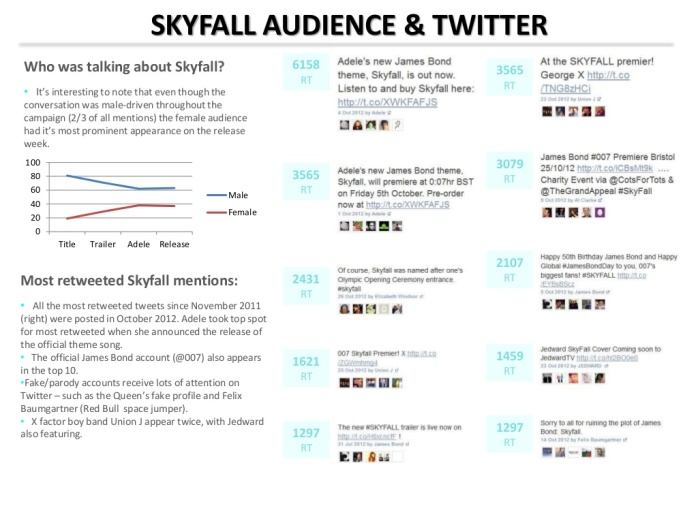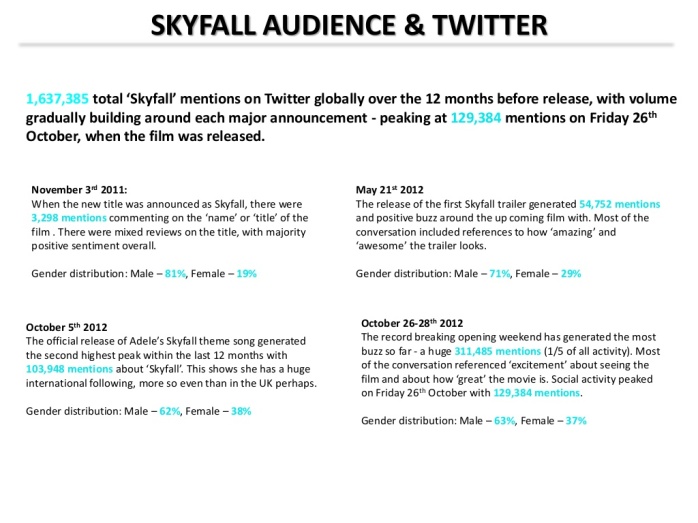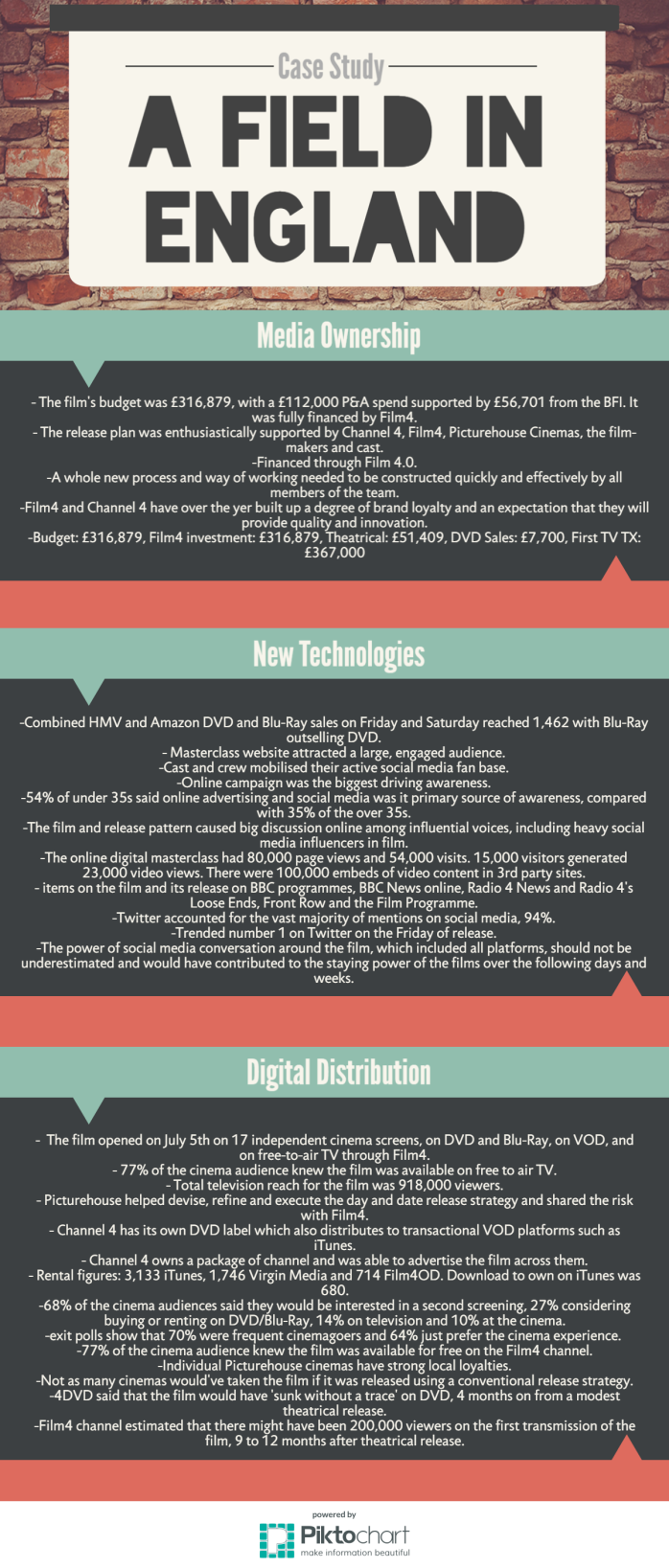June, 2015:
To what extent does media ownership have an impact on the successful distribution of media products in the media area that you have studied?
PLAN:
- The Big Six – Hollywood has long been ruled by the studio system. The studio system includes a selected number of ‘major’ studios who engage in film production & distribution. They release a substantial number of films every year & earn a major share of box office revenues. With significant changes marking the turning points in Hollywood, the frontrunners become the ‘big’ studios. The current ‘Big Six’ came into being from 1990 to 1995, when Hollywood became more of a conglomerate than a mere film production & distribution unit. The ‘Big Six’ collectively command approximately 80 – 85 percent of US & Canadian box office revenue. These ‘Big Six’ are: 20th Century Fox, Warner Bros., Paramount Pictures, Columbia Pictures, Universal Pictures & Walt Disney Pictures. These film studios dominate both American cinema & the global film industry. Most films that reach the international audience, in multiple continents & in multiple languages, are usually produced and/ or distributed by one of these, thus making them the Big Six.
- Skyfall – Tentpole release (Big 6). Skyfall was produced by Eon Productions and distributed by MGM and Columbia Pictures (both owned by Sony). Columbia Pictures is one of the ‘Big Six’. Heineken paid £28 million to the films budget to allow for there product placement in the film and in subsequent film TV ad featuring some of Skyfall’s cast. Heineken backed the marketing of Skyfall with its digital activity on Google and social media marketing on Facebook. Cross media convergence – Sony owns multiple media companies and utilised all of them to help advertise Skyfall (adele song). The production company decided to create publicity by performing a stunt at the london 2012 Olympics opening ceremony involving the queen. Popular worldwide because Sony have the power to distribute their films worldwide. Released in IMAX cinemas because Big Six have the power to do this.
Worldwide Box Office $1,110,526,981
- Prometheus – Big Six release. Produced by 20th Century Fox (Big Six) – offered him more money to make the film a PG which he obviously refused as the film has a 12 age certificate. Lindelhof approached fox and told them with his new re-writes they could do this thing for considerably less and apparently the studio agreed with him and cut the budget down to between 100 and 150 Million. Released in IMAX cinemas because Big Six have the power to do this. Film company and cast of the film made videos that went viral to help the marketing of prometheus ( TED talk from the future and robot named David). Released numerous ‘teaser’ trailers to provoke interest in the film.
- Field in England – Independent release (day and date strategy). Film4 and Channel 4 have over the years built up a degree of brand loyalty and an expectation that they will provide quality and innovation.Budget: £316,879, Film4 investment: £316,879, Theatrical: £51,409, DVD Sales: £7,700, First TV TX: £367,000. Released using a day and date release strategy (first time this had been done so gained publicity). The release plan was enthusiastically supported by Channel 4, Film4, Picturehouse Cinemas, the film-makers and cast. The film opened on July 5th on 17 independent cinema screens, on DVD and Blu-Ray, on VOD, and on free-to-air TV through Film4 all at the same time. The individual Picturehouse cinemas helped devise, refine and execute the day and date release strategy and shared the risk with Film4. The innovative release strategy was so unique that it was widely talked about which created interest (especially in fans of Wheatley’s other films) to watch the film. Offered Q&A sessions after cinema screenings which greatly improved theatrical profits. Channel 4 owns a package of channel and was able to advertise the film across them.
- British Guide To Showing Off – Independent release (social media stratergy) strategy as it had the best methods of running the social media release. Produced a Facebook app called ‘Show Off’. The ‘Show Off’ app provided users the opportunity of editing photos (their or their friends’ Facebook photos or an upload) using a toolkit. Toolkit included costumes and accessories from the Alternative Miss World shows plus other relevant imagery. An Open Source format allowed Users to add their own imagery to the toolkit (following moderation). Upon upload users got the option to download a Happy Club certificate, thereby became members of Andrew Logan’s ‘Happy Club’. All user generated content was shareable via Facebook, Twitter, Google+ and the Send function. The interactive Facebook page included key information on the film, links to cinemas playing the film, and a ‘Show Off’ App. Updating the site at domain britishguidetoshowingoff.com, Essence built a website using promotional imagery attached to the film. The site hosted the film’s trailer, a live Twitter feed and external links to social assets and theatrical venues playing the film. Tweets with the #ShowingOff hashtag, fans questions were answered at a pre- arranged Andrew Logan Twitter Tea Party. Essence controlled all outlets on social media sites. Social media strategy managed by Essence ran from 3rd October 2011 to 27th November 2011, and was managed before and since by the filmmakers, in conjunction with Verve Pictures.
Version 1 of essay:
Hollywood has long been ruled by the studio system. The studio system includes a selected number of ‘major’ studios who engage in film production & distribution. They release a substantial number of films every year and earn a major share of box office revenues. With significant changes marking the turning points in Hollywood, the frontrunners become the ‘big’ studios. The current ‘Big Six’ came into being from 1990 to 1995, when Hollywood became more of a conglomerate than a mere film production and distribution unit. The ‘Big Six’ collectively command approximately 80 – 85 percent of US & Canadian box office revenue. These ‘Big Six’ are: 20th Century Fox, Warner Bros., Paramount Pictures, Columbia Pictures, Universal Pictures & Walt Disney Pictures. These film studios dominate both American and British cinema and the global film industry. Most films that reach the international audience, in multiple continents and in multiple languages, are usually produced and/or distributed by one of these, thus making them the Big Six. The Big Six are considered to have the most power in the film industry.
Tentpole releases are often produced and/or distributed by one of the Big Six. A tentpole release is a film that will almost certainly make back the money that was used in the making of the film. They are films that people know will be big hits and if a tentpole release is not successfully it can ruin a film company. Skyfall is an example of a successful tentpole release. Skyfall was produced by Eon Productions and distributed by MGM and Columbia Pictures who are both owned by Sony. Columbia Pictures are part of the Big Six. Skyfall had a huge budget for the production of the film, with the beer company Heineken paying £28 million for product placement in the film and in subsequent film TV ad featuring some of Skyfall’s cast. Heineken also backed the marketing of Skyfall with its digital activity on Google and social media marketing on Facebook. Skyfall also generated interest in the film with a stunt involving the queen at the London 2012 olympic opening ceremony, this is clearly a huge event that any film company that is not part of the Big Six would struggle to achieve as they would not have the power to be part of something as big as the olympics. But with the amount of people that watch the Olympics it was a great way to market the film. Sony also used cross media convergence in the advertising of Skyfall as Sony owns multiple media companies and used them to its advantage, for example the Adele song. Adele is an artist under sony’s record label and also produced the theme song for Skyfall. This song was very popular and made UK number 1 so helped market the film by spreading awareness of the film. Being part of the Big Six, Columbia Pictures had the ability to distribute the film worldwide and in IMAX cinemas. Skyfall made $1,110,526,981 in Worldwide Box Office. Skyfall was distributed very successfully and was very popular among UK audiences, this being due to the fact that it was marketed very well and Sony had a huge budget to spend on the film.
Prometheus is another film that was produced by one of the Big Six, 20th Century Fox. This film was also released in IMAX cinemas because again 20th Century Fox have the power to do this with being part of the Big Six. Prometheus was marketed very well as the film company and cast of the film made videos that went viral to help the marketing of prometheus. They made a TED talk from the future and a couple of videos about a robot named David, they also released numerous ‘teaser’ trailers that provoked interest in the film and encouraged people to go see it. 20th Century Fox offered Ridley Scott more money to make the film a PG which he obviously refused as the film has a 12 age certificate. Lindelhof approached fox and told them with his new re-writes they could do this thing for considerably less and apparently the studio agreed with him and cut the budget down to between 100 and 150 Million. This was not a problem though as the film still made $403,354,469 worldwide.
in contrast to these film releases by big film companies is a Field In England, an independent film that was released in a very unique way. A Field In England was distributed by Film4. Film4 and Channel 4 have over the years built up a degree of brand loyalty and an expectation that they will provide quality and innovation. Channel 4 owns a package of channel and was able to advertise the film across them. The film was released using a Day and Date release strategy.The release plan was enthusiastically supported by Channel 4, Film4, Picturehouse Cinemas, the film-makers and cast. The film opened on July 5th on 17 independent cinema screens, on DVD and Blu-Ray, on VOD, and on free-to-air TV through Film4 all at the same time. The individual Picturehouse cinemas helped devise, refine and execute the day and date release strategy and shared the risk with Film4. The innovative release strategy was so unique that it was widely talked about which created interest, especially in fans of Wheatley’s other films, to watch the film. Wheatley offered Q&A sessions after cinema screenings which greatly improved theatrical profits. A Field In England was the first film to use this release strategy and that is one of the main reasons it was successful because it was new and made people talk about the film. This means that the strategy probably wouldn’t work for other films.
Another independent film that was released in a unique was is A British Guide To Showing Off. Verve Pictures were the distributor of this film. Verve Pictures were looking for a social media agency to handle the strategy for the release of the film. Of the 4 companies that pitched to Verve Pictures, Essence was the chosen partner to handle the release strategy. Essence had the best central idea, and the best methods of running the overall campaign. Essence produced a Facebook app called ‘Show Off’. The ‘Show Off’ app provided users the opportunity of editing photos (their or their friends’ Facebook photos or an upload) using a toolkit. Toolkit included costumes and accessories from the Alternative Miss World shows plus other relevant imagery. An Open Source format allowed Users to add their own imagery to the toolkit (following moderation). Upon upload users got the option to download a Happy Club certificate, thereby became members of Andrew Logan’s ‘Happy Club’. All user generated content was shareable via Facebook, Twitter, Google+ and the Send function. The interactive Facebook page included key information on the film, links to cinemas playing the film, and a ‘Show Off’ App. Updating the site at domain britishguidetoshowingoff.com, Essence built a website using promotional imagery attached to the film. The site hosted the film’s trailer, a live Twitter feed and external links to social assets and theatrical venues playing the film. Tweets with the #ShowingOff hashtag, fans questions were answered at a pre- arranged Andrew Logan Twitter Tea Party. Essence controlled all outlets on social media sites. Social media strategy managed by Essence ran from 3rd October 2011 to 27th November 2011, and was managed before and since by the filmmakers, in conjunction with Verve Pictures. The social media release was important for the marketing of A British Guide To Showing Off. It raised awareness of the film in a fun way and got people talking so therefore was quite successful.
The Big Six film companies find it easier to successfully distribute films because they have the money and power to do so. They can utilise many types of media and push their films into cinemas worldwide. However for independent films they have to be more creative to be successful in their distribution. They have to use unique strategies to raise awareness, usually by word of mouth. The more people they get talking about the film or the way it’s released or what they’ve seen on social media, the more people will go and see the film in cinemas and buy the film on DVD and VOD and therefore the more likely the film is to be successful and make back its money.



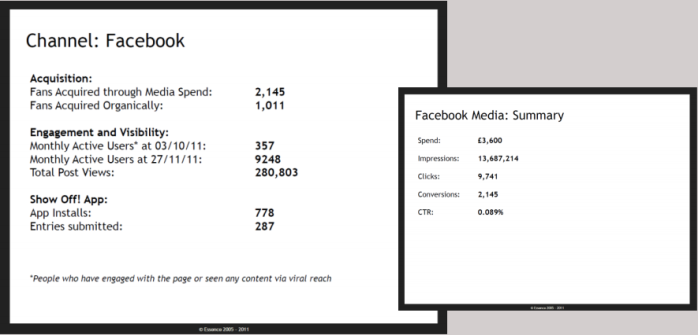
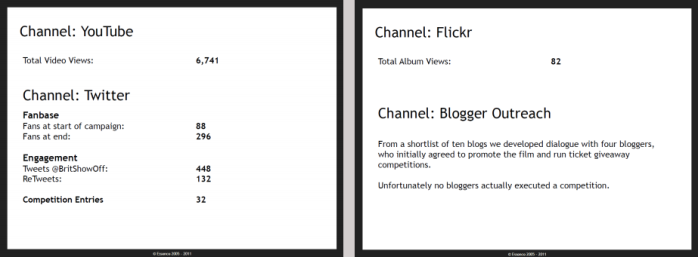

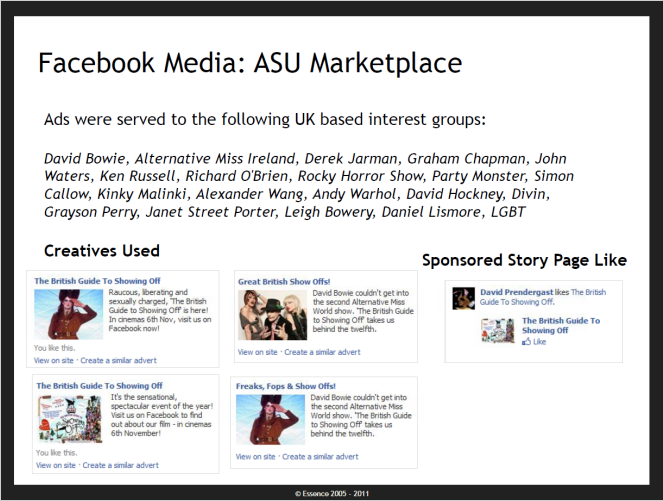
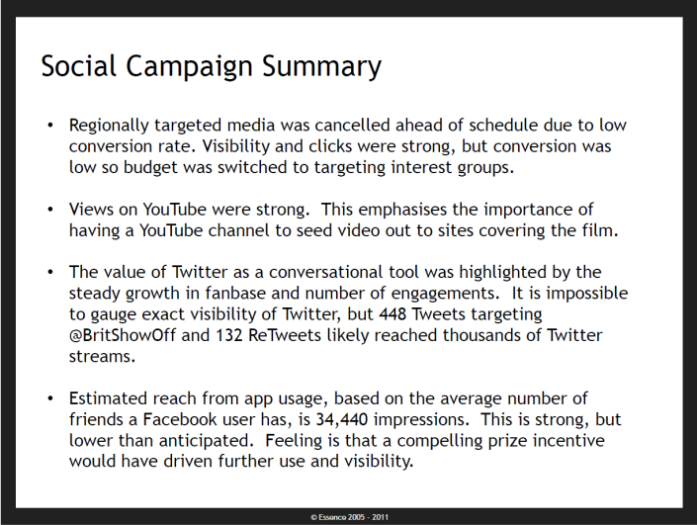 Digital Distribution:
Digital Distribution:

